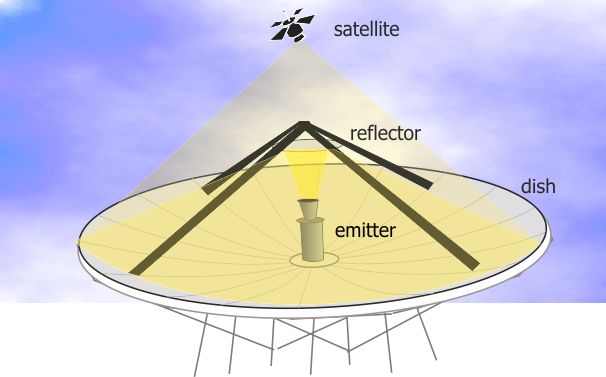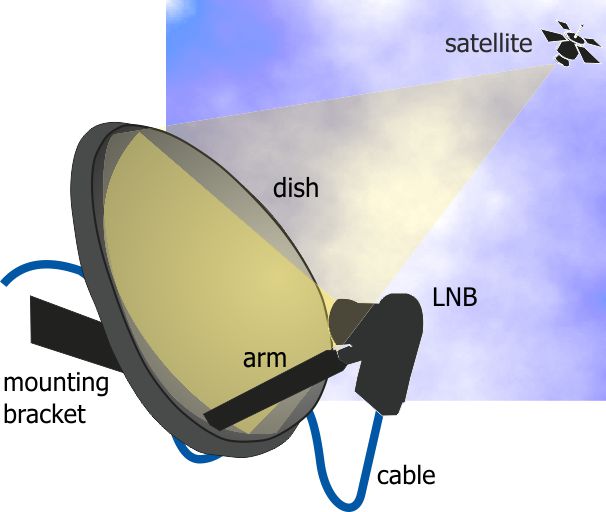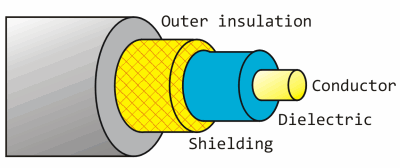Freesat reception - all about dishes
 Brian Butterworth published on UK Free TV
Brian Butterworth published on UK Free TV Satellite reception has both advantages and disadvantages compare with terrestrial (aerial) reception.
By using much higher frequencies (gigahertz, compared to terrestrial televisions megahertz) more transmission channels called transponders (the satellite equivalent of multiplexes) can be provided. For example, there are only six Freeview multiplexes, but Sky or Freesat users can access two hundred satellite transponders.
Aside from exceptional weather conditions (very heavy rain for example) digital satellite provides stable pictures and audio. Where Freeview transmitters are no more than 732 metres above sea level, the geostationary satellites used for television are 35,800,000 metres above the equator so reception is possible even where buildings, trees and hills make terrestrial reception impossible.

The downside of the transmitters being 22,300 miles up in the air is that the signals are very, very weak - so standard TV aerial is of little use. When the signals are sent to the satellites, huge dish transmitters are used to uplink the signal to the satellite. These are tens of metres from side to side, and feature an emitter that generates the signal, which is first bounced of a mirror (called a reflector) and then off the surface of the parabolic dish.

There are many satellites in the sky over the equator. Often these are in clusters over a particular position, for example there are four used for UK television are at 28.2 degrees east. There is another cluster over the 19.2 degrees east positions that are used for German television.
To receive these very weak signals from the satellite, it is necessary to use a dish for reception too. By using a reflective dish, this concentrates the signals onto a small device called a LNB. This is held in front of the dish by a metal arm.

The size of dish for reception is typically much smaller; often 60cm to 100cm in diameter, but the exact size depends upon the transmitting satellite transponder. To keep the transmission power levels down to levels that can be powered by the satellite's solar panels, each beam is focused on a particular area of the Earth's surface. If you are trying to receive the signal at the centre of this zone, a small dish is required. At the outer edges, you may need a 5 metre dish. Maps of these zones are provided by the satellite companies, and are called satellite footprints.
When the dish is installed it must be aligned carefully as the signal is very weak. The installer needs to know the inclination and the azimuth from the ground location to the satellite. If you install yourself you will find that there are markings on the dish that are used to point the dish in the correct position. It is important that the view of the satellite will not be blocked, so must take into account leaves growing on trees and potential building works.
For many people the LNB will have a single cable connected to it, however if you have Sky+ or a multi-room installation the LNB package will actually contain four receivers a quad-LNB. Unlike terrestrial television where you can split the aerial cable to feed more than one Freeview box or television set, with satelite reception you cannot. So, a Sky+ box with two receivers (so you can watch one thing and record another) has two cables connecting the box to the dish.
The cable that connects the dish to the receiver must be satellite grade cable. Whilst this looks superficially like the cable used to connect and aerial to a television, a higher grade cable is required for satellite reception.
Here is an image of a co-axial cable. This sort of cable is used to connect any type of receiving aerial to the reception equipment.

RG6, PF100 and PH100 are all types of coax cable that are suitable for the very weak signals that are received by a satellite dish. (The power is the same as you would receive from a one-bar electric heater on the moon).
The conductor in the centre passes the signals received from the dish to the set-top box. This is made from steel in RG6 cable, and from copper in the RF100 and PH100 types. This makes RG6 less suitable in the UK where rain can damage the cable.
The shielding is responsible for keeping unwanted external interference from damaging the signal. In the cheaper cable this will be a foil wrap, in better specified cables this is a braid (or mesh) of copper wires. The sheild in the RF100 covers 58% of the cable.
The non-conducting layer between the shield and the conductor is called the dielectric. This can be either a solid (RG6), foam (RF100) or air-spaced (PH100) dielectric. This makes the cables progressively more flexible (ie bendy without damage).
5:19 PM
I live in NE Scotland. With my Sky+ box I can tune to ITV HD ('Other channels')but without having any other functionality like recording etc. Is it possible to fool my Sky+ outfit into thinking that it is situated in England - and can therefore receive ITV HD with full resources (especially recording). I am not bothered about ITV regional considerations. Thanks.
| link to this comment |
8:49 PM
Geoffrey: The "other channels" facility is the only method you can use with a Sky+ box to receive channels from another area, as unlike a Freesat box where its possible for the user to place themselves anywhere in the UK by simply entering a post code appropriate to the desired area in the set up menu, unfortunately this is not possible with Sky devices as that data is programmed into the Sky card when its sent to you, something that Sky are most reluctant to alter as they like keeping a strict check on a subscribers location.
| link to this comment |
2:13 PM
Jack: The most likely cause is that your dish has moved out of alignment and needs re-configuring. An installer with a professioonal meter will be able to correct this and would additionally be able to determine whether the LNB was functioning correctly.
| link to this comment |
9:12 PM
Hi.
I had a free-sat system(MANHATTAN PLAZA DS.100) fitted thru the disability scheme for £29 all inclusive earlier this year. within the last couple of weeks,it has started freezing and at times losing signal altogether.This is usually when it is raining or high winds. What do i have to do to put this right please as my tv is my only pleasure now.
Regards,
Thomas
| link to this comment |
11:20 PM
Thomas: Weather related problems are always associated with either the alignment of the dish or alternatively the connections to the LNB on the end of the dish arm.
The first thing to do is to carry out a signal strength test on any station that you might be viewing, because the strength / quality indications seen should both be sitting about the same levels as each other and with the level being the minimum of 50% or so, if though any of the two are under this then the dish is slightly out of alignment.
However should this test indicate that all seems to be in order, then your problem is most likely being caused by water having gained access to the "F" plug connector on the end of the coax thats goes into the dishes LNB, this requiring to be unscrewed from the LNB and then further unscrewed from the coax for purposes of drying out, then re taping with self amalgamating tape once refitted onto the LNB.
| link to this comment |
10:26 AM
Hi JB38.
Thanks for your advice.
Ive just phoned 'EuroAerials',who installed my freesat thru the disability scheme & i was told,quite rudely, that "rain & wind will affect my signal as it has to come from a long way up in space". The woman said there is nothing wrong with the installation & its normal!!!!
Any ideas on what i can do now please?
Regards,
Thomas
| link to this comment |
9:43 PM
Thomas Fuller: What you have been told by these people is just a standard line used by some of these types designed to fob you off, as wind no matter how strong, will NOT cause any problems with satellite reception unless either the dish mounting is slack, or alternatively that there is a tree located near to the dish and the wind is causing its foliage to partially obstruct the dish.
If a dish has been installed correctly, and many are not!, then only a really heavy thundery downpour can sometimes cause the signal to fail for a few minutes, but only for that very short time.
I do not at present have the manual for that model you have been supplied with, but have a look in the tuning menu for the signal checking facility and if found give an update on the indications seen, as both indicator bars (strength & quality) should be at a minimum of the equivalent of 60% for reasonably reliable reception.
| link to this comment |
12:06 AM
Thomas Fuller: If you had equipment fitted by the BBC Help scheme then you should phone them (0800 40 85 900) as you have a 12 month after care service - they should send someone out if they can't rectify it over the phone.
| link to this comment |
2:24 PM
My television was not used for a few days over xmas. When I switched on again I was getting no signal from the dish. I called out an engineer,he find no fault with the dish or cable, but still no signal. when he removed either of the 2 coaxes signal was restored amd the TV worked ok. He said there was a fault in the box. I have now put the coax back and everything is working. Could this be a problem with damp getting in.
| link to this comment |